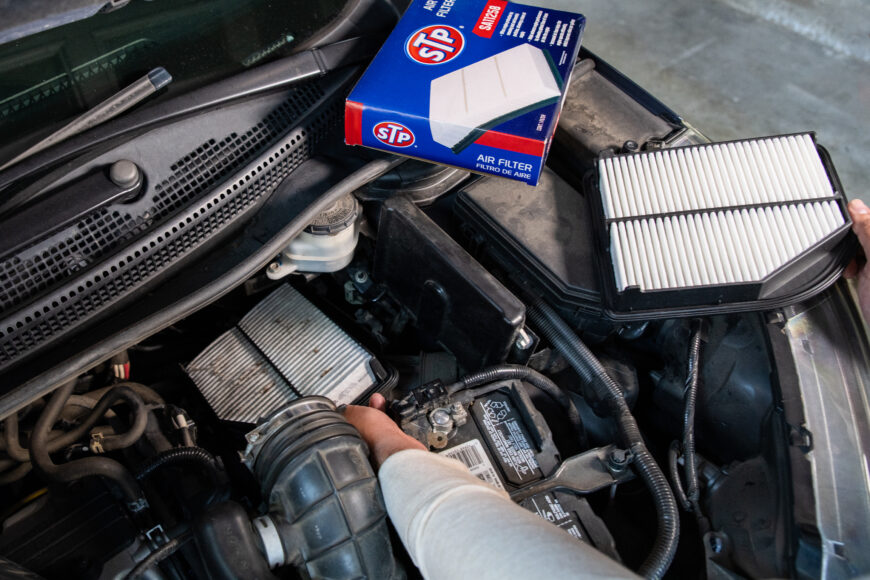UNDERSTANDING THE ROLE OF AN AIR FILTER
An engine air filter is a physical barrier that air must pass through before it enters the engine for combustion. It’s made of natural and/or synthetic fibers that capture and hold contaminants that could otherwise damage an engine. For example, fine sand particles that carry into the air intake can cause microscopic scratches in the cylinder walls if they aren’t filtered out. Essentially, only clean air passes through the air filter element and into the engine.
As it relates to engine performance, a clean air filter:
- Prevents contamination. Particles like pollen, debris, bugs, and leaves are captured before they get into the engine.
- Optimizes combustion. A precise mixture of air and fuel is required, and a clean air filter ensures that only clean air reaches the combustion chamber, contributing to a proper air-fuel mixture.
- Promotes fuel efficiency. When the engine has a full supply of clean air, the engine can better use the fuel it burns for power production.
- Helps to reduce emissions. When the engine runs at its best, it produces fewer pollutants.
SIGNS YOUR AIR FILTER NEEDS ATTENTION
To keep problems at bay, a dirty air filter should be changed. Signs of a dirty air include:
- Visibly dirty pleats. If you can’t see light through the air filter and there is dirt and debris caught between the pleats, it’s time to change it.
- Worsening fuel economy. If you aren’t going as far on a tank of fuel, it could be due to a bad air filter.
- Unusual engine sounds. Pinging or knocking can be attributed to poor airflow into the engine.
- Poor acceleration. With insufficient air flowing into the engine, less power is produced, yielding poor acceleration.
- Check Engine Light. When the problem gets severe, it’s possible that the Check Engine Light illuminates due to sensor readings like the MAF sensor outside of normal values.
When these symptoms appear, inspect the air filter to determine if it’s dirty, clogged, or damaged and needs to be replaced.
HOW TO INSPECT YOUR AIR FILTER
Before you inspect the air filter, make sure the engine is off. You don’t want to allow any dirt or debris to be accidentally drawn in while the filter is out. To check your air filter:
- Locate the air filter housing. The air filter is typically housed in a rectangular or circular plastic container near the front of the engine.
- Open the air filter housing. Depending on your vehicle, you may need to use a screwdriver or release latches to open the air filter housing. Some vehicles have quick-release clips or screws securing the housing.
- Remove the old air filter. Carefully remove the existing air filter from the housing. Note its orientation, as you’ll need to install the new filter in the same way.
- Inspect the air filter. Hold the air filter up to a light and inspect it. Look for signs of dirt, dust, debris, or damage. If the filter appears clogged, wet, or excessively dirty, it’s time for a replacement.
- Tap or blow out debris. If the filter is only mildly dirty, you can tap it gently on a solid surface or use compressed air to blow out loose debris. However, this is a temporary solution, and if the filter is significantly dirty, it’s best to replace it.
- Clean the air filter housing. While the air filter is out, take a moment to inspect and clean the inside of the air filter housing if necessary. Ensure that no debris or contaminants remain inside.
- Install a new air filter. If you’ve determined that the old filter is dirty or damaged, install a new, clean air filter. Follow the orientation noted during the removal.
- Secure the air filter housing. Close and secure the air filter housing, ensuring that it is properly sealed to prevent unfiltered air from entering the engine.
You should inspect the air filter every time you service your vehicle, like when you change the engine oil and filter.
BENEFITS OF REGULAR AIR FILTER MAINTENANCE
To keep dirty air filter symptoms from ruining our car’s longevity and economy, include air filter replacements as part of your regular maintenance routine. It’s best to replace the air filter – or at least, clean it out – once per year, or more frequently if it’s required. By doing so, you can keep your engine running as fuel efficiently as possible, assuming that all other systems are maintained as well.
Keeping the air filter clean helps to extend engine life and prevent premature wear and tear that will eventually require expensive repairs. And with the full volume of clean, fresh air that your engine demands, you’ll get the best power production from it.
When you’re due for a new air filter, shop at AutoZone. Find premium filter solutions from brands you trust whether you shop in-store or online.
FAQ/PEOPLE ALSO ASK



